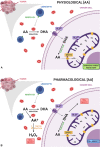Therapeutic Use of Vitamin C in Cancer: Physiological Considerations
- PMID: 32194425
- PMCID: PMC7063061
- DOI: 10.3389/fphar.2020.00211
Therapeutic Use of Vitamin C in Cancer: Physiological Considerations
Abstract
Since the early studies of William J. McCormick in the 1950s, vitamin C has been proposed as a candidate for the treatment of cancer. A number of reports have shown that pharmacological concentrations of vitamin C selectively kill cancer cells in vitro and decrease the growth rates of a number of human tumor xenografts in immunodeficient mice. However, up to the date there is still doubt regarding this possible therapeutic role of vitamin C in cancer, mainly because high dose administration in cancer patients has not showed a clear antitumor activity. These apparent controversial findings highlight the fact that we lack information on the interactions that occurs between cancer cells and vitamin C, and if these transformed cells can uptake, metabolize and compartmentalize vitamin C like normal human cells do. The role of SVCTs and GLUTs transporters, which uptake the reduced form and the oxidized form of vitamin C, respectively, has been recently highlighted in the context of cancer showing that the relationship between vitamin C and cancer might be more complex than previously thought. In this review, we analyze the state of art of the effect of vitamin C on cancer cells in vitro and in vivo, and relate it to the capacity of cancer cells in acquiring, metabolize and compartmentalize this nutrient, with its implications on the potential therapeutic role of vitamin C in cancer.
Keywords: GLUT; SVCT2; cancer; cancer therapy; vitamin C; vitamin C transporters.
Copyright © 2020 Roa, Peña, Gatica, Escobar-Acuña, Saavedra, Maldonado, Cuevas, Moraga-Cid, Rivas and Muñoz-Montesino.
Figures

References
Publication types
LinkOut - more resources
Full Text Sources

